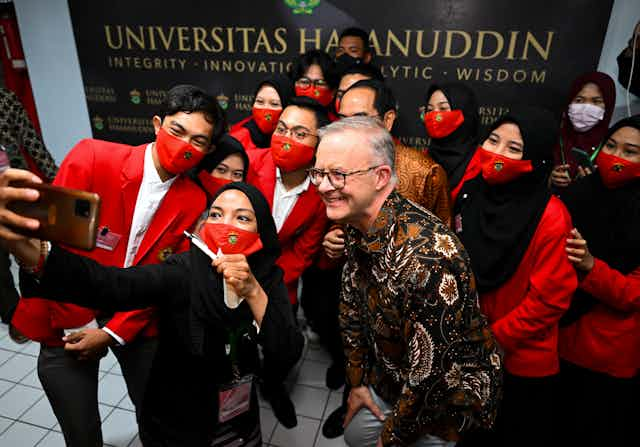This year marks 50 years since Australia established diplomatic ties with the Association of Southeast Asian Nations (ASEAN), the political bloc that represents over 650 million people across 10 countries in the region.
Over the years, the relationship has benefited both sides. In 2022, for instance, trade between Australia and ASEAN reached around A$178 billion – greater than our two-way trade with Japan, the United States or the European Union.
However, this is a pivotal time in the region with many pressing challenges, from the ongoing conflict in Myanmar to competing claims and rising tensions with China over the South China Sea.
In research for a new report being released today for the start of the ASEAN-Australia Special Summit – written with scholars Lina A. Alexandra from Indonesia, Sharon Seah from Singapore and Kimly Ngoun from Cambodia – we identified many challenges facing the relationship.
For example, many of the analysts, academics, policymakers and young leaders we interviewed said Australia has rarely, if ever, been as attentive to Southeast Asia as it has in recent years.
These experts wondered whether this level of enthusiasm, resourcing and engagement could survive a significant geopolitical or economic shock. They raised gentle questions about the viability of long-term Australian engagement in the region at a time when migration, terrorism and strategic competition are, once again, prominent in the Australian public debate.
As one senior Indonesian analyst told me:
It is natural that relations between Australia and ASEAN should be good. We take this for granted. And we take for granted that it will still be in good in the future. But might it not be so good?
‘We have a very positive sense of Australia’
In our study, we found the greatest divergence of views on the strength of the relationship is not based on geography. Rather, it is generational.
The emphasis among older, established analysts and policymakers is on sustaining institutional links and maintaining high-level connections between the two sides – traditionally considered the essence of good diplomacy.

Younger leaders, however, were almost all heavily focused on the need to find more innovative and creative ways to foster exchanges. Many had their earliest experiences of ASEAN-Australia engagement during the COVID-19 pandemic, when they were confined to home and connected to the world through Zoom and other virtual meeting spaces.
They would also like greater opportunities to connect with like-minded, emerging Australian leaders, particularly on issues related to the environment, and social and human rights.
The reality, according to one young ASEAN leader, is “we have a very positive sense of Australia, but the Australia-ASEAN relationship isn’t something that immediately comes to mind”.
The reason, he suggests, is that the great power rivalry between the United States and China dominates much of the discussion among leaders in Southeast Asia. This leaves less space to consider other important countries contributing to the region’s success, such as Australia.
On the flip side, Australians have likely underestimated the importance of ASEAN and its role in resolving conflicts “in a quiet and understated way”, as one senior Australian business figure told me. He added:
We have often desperately underestimated the value of ASEAN for managing China. […] Because in Southeast Asia they’re not shouting we assume they are subservient.
Rather than presuming to act as mediator or providing our own guidance on managing these relationship, perhaps the more prudent Australian approach would be to spend as much time as possible listening. There are many thoughtful voices in the region considering their own futures adjacent to China.
Read more: Why is southeast Asia so concerned about AUKUS and Australia's plans for nuclear submarines?
The next generation leading the way
In this context, our report offers some recommendations on how to develop a stronger Australia-ASEAN partnership.
In response to what younger Southeast Asian leaders told us, for instance, we believe a future-focused ASEAN-Australia Centre should be established. This centre could focus on analytically driven and commercially oriented ways to bring Australia and Southeast Asia even closer together.
Australia has also invested heavily in developing educational ties with Southeast Asia, and has become a top education destination for many students. What is lacking, however, is a model to better integrate these students, creating a shared sense of purpose, direction and belonging.
This would provide more opportunities for high-potential future leaders to build connections with one another from a young age. As one youth leader told us:
There is a chance to build a bridge where Australia can also help us to better figure ourselves out.
The ASEAN-Australia Strategic Youth Partnership is already partly fulfilling this appetite for engagement. It has more than 300 members aged 18-29 from Australia and every ASEAN member. The Australia-ASEAN Emerging Leaders Program (or A2ELP, for short) is another organisation geared toward Southeast Asian and Australian social entrepreneurs.
They are a great start. We should now build on the fact Australia has a wide constellation of universities, think tanks, community organisations and other stakeholders that are deeply committed to further developing connections between the regions. For instance, a number of universities have already set up campuses in Southeast Asia, such as RMIT University in Vietnam, Monash University in Malaysia and James Cook University in Singapore.
And a growing number are looking to expand specifically in Indonesia, following the lead of Monash in recent years.
It’s important for graduates to also have greater opportunities to live and work in Australia – and vice versa. Australia’s recent moves towards supporting working holiday visas for young Southeast Asians are a good example, as are the New Colombo Plan scholarships, which support Australian undergraduates studying and undertaking internships in the Indo-Pacific region.
We should now look for other ways to foster talent mobility between Australia and the ASEAN members. As one emerging leader in Southeast Asia who wants to spend more time in Australia explained:
Australia is really open, with good work-life balance, and a business culture that brings people together.

